Power Supply Units with 800-860 W Capacity: 4 Models Reviewed

Power supply units with about 800 W capacity are an optimal choice for pretty powerful gaming rigs these days. They can easily power a couple of high-end graphics accelerators and a fast CPU (even at non-nominal frequencies), but their price is not too high at the same time. Today we will talk about four great products like that from Chieftec, Cooler Master, Corsair and Seasonic.
We’ll be talking in this review about four PSUs with a wattage rating of 800 to 860 watts. Such products are the most popular choice for top-end gaming systems that are not pushed to the extremes in configuration and overclocking. A PSU like that can easily power any desktop CPU plus a couple of top-end single-processor graphics cards plus a large disk array. The components can even be moderately overclocked and there will still be enough of reserve power for any emergencies.
Of the four PSUs we’ve got for this test session two are familiar to us. We’ve already tested same-series 1000W models from Seasonic and Cooler Master and the lower-wattage models do not differ much in their design. In fact, we only have to make sure that these PSUs are as high quality as their senior cousins.
The PSUs from Chieftec and Corsair come from new series we haven’t yet covered in our reviews, but their interior turns out to be very similar. This pair, being unfamiliar to us as yet, comes first.
Testing Methodology
The following article offers a detailed description of our testing methodology and equipment and a brief explanation of what the specified and tested parameters of power supplies mean: X-bit Labs Presents: Power Supply Units Testing Methodology. If you feel overwhelmed with the numbers and terms this review abounds in, refer to the Methodology.
You can also go to our Cases/PSU section to check out reviews of all other PSU models we have tested in our labs.
We will mark the actual power consumption of three system configurations (discussed in our article PC Power Consumption: How Many Watts Do We Need?) in the cross-load diagrams. This will help you see if the tested PSU can meet the requirements of a real-life PC.
Testing Participants
Chieftec BPS-850C2
We are already familiar with Chieftec’s Nitro 85+ series and they did well in our earlier tests. The BPS-850C2 comes from the new Nitro II 85+ series and currently represents its flagship model (the previous series went up to 1200 watts). The user manual says that the wattage range of modular models ends at 1200 watts, just like with the original Nitro 85+, but the manufacturer’s website doesn’t mention any products above 850 watts.
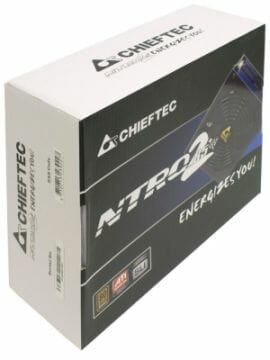
The BPS-850C2 is shipped in a plain-looking box which is not large and has no carry handle. The box design is uniform for all models in the series.
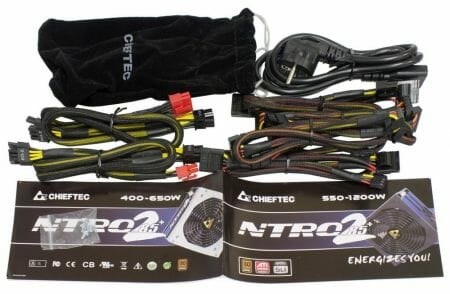
The accessories only include a user manual, a mains cord, modular cables and a pack with screws. The only extra accessory is the small velvet pouch for unused modular cables.
Exterior Design
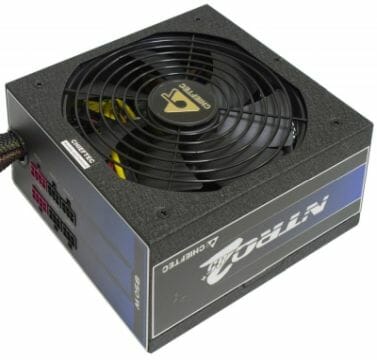
The exterior design is Chieftec’s typical: the rough dark-gray paint seems to have become a distinctive trait of the company’s PSUs. The nonstandard fastening of the top panel, with two screws at the top and two more on each side panel, is a distinctive feature, too.
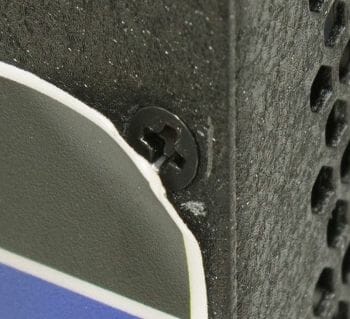
We had to peel off the label to uncover some of the screws. The PSU doesn’t look neat as the result.
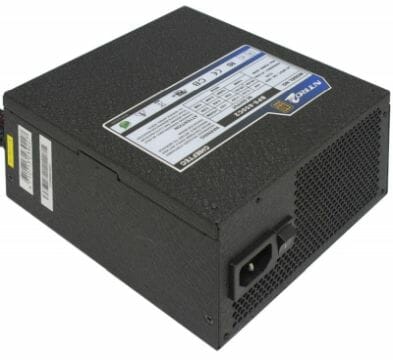
The sticker with product specs is shaped originally, not like a conventional rectangle. An On/Off switch can be found on the back panel next to the mains connector. The back panel is mostly a vent grid.
Circuit Design
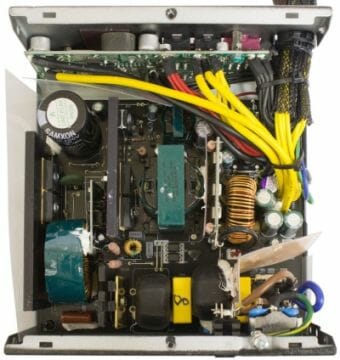
According to the marking on the power transformer, the PSU is developed by Channel Well. The product specs suggest the CWT PUQ (B) series because they coincide with those of the highest-wattage CWT PUQ (B) model. By the way, this explains the fact why there are no higher-wattage models in the Chieftec Nitro II 85+ series as yet. The original Nitro 85+ series was based on the CWT PSH II platform.
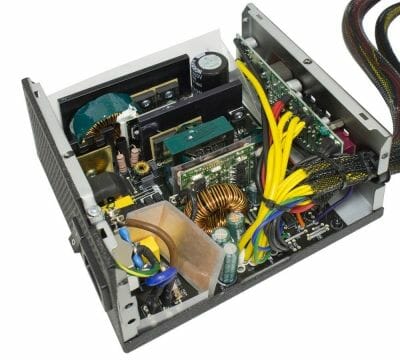
There’s only one choke in the output circuitry area. It is used to produce +12V voltage.
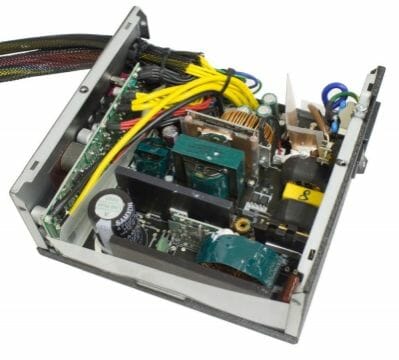
The rest of the voltages are produced by means of DC-DC converters located on the card with modular connectors.
The overall component density isn’t high because the DC-DC converters reside on the modular connectors card while the synchronous rectifier transistors have a dedicated daughter card for themselves. There are a lot of fuses on the main PCB.
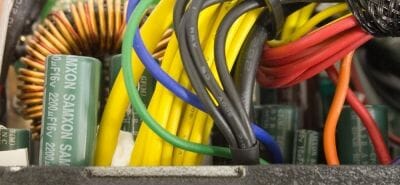
The PSU has electrolytic capacitors from SAMXON at its output. That’s not a big name, but SAMXON components seem to be high quality.
Cables and Connectors
The Chieftec BPS-850C2 is equipped with the following cables and connectors:
- One mainboard cable with a 20+4-pin connector (57 cm)
- Two CPU power cables with one 4+4-pin connector on each (60 cm)
- Two connectors for graphics card power cables
- Four connectors for peripheral power cables
Included with the PSU are:
- Two graphics card cables with two 6+2-pin connectors on each (60+15 cm)
- One cable with two PATA power connectors (61+15 cm)
- One cable with two PATA power connectors and one floppy-drive plug (61+15+15 cm)
- Two cables with four SATA power connectors on each (60+15+15+15 cm)
This selection of cables is quite sufficient for any configuration the PSU can power but we wish the CPU power cables were longer. 60 centimeters is going to be too short to hide the cable behind the mainboard in a system case with a bottom PSU bay.
We don’t mind that both CPU connectors consist of two 4-pin halves. These halves can be tightly joined and easily plugged into a mainboard’s 8-pin receptacle.
Specifications
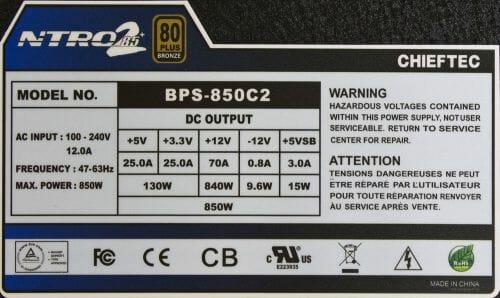
As we’ve mentioned above, the PSU is identical to the original CWT model in its specifications. And we can’t find any problem about them. The PSU can yield almost all of its output power via the most important +12V rail (it is not split into multiple virtual lines, which is good, too). The load capacity of the other rails will easily meet the requirements of any possible PC configuration.
Like its Channel Well progenitor, the Chieftec BPS-850C2 complies with the 80 PLUS Bronze standard.
UPS Compatibility
Working with our APC SmartUPS SC 620, the Chieftec BPS-850C2 was stable at loads up to 385 watts when powered by the mains but could only switch to the UPS’s batteries at 285 watts.
Cross-Load Voltage Stability
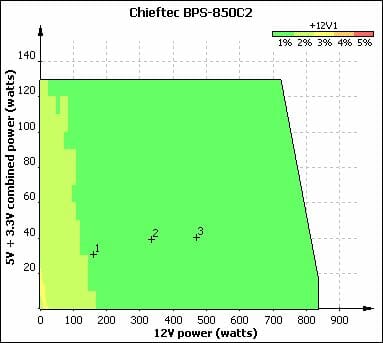
The most important +12V voltage remains within 2% of the required level at most loads. There is but a tiny fragment of the diagram where it is 3% off at low loads.
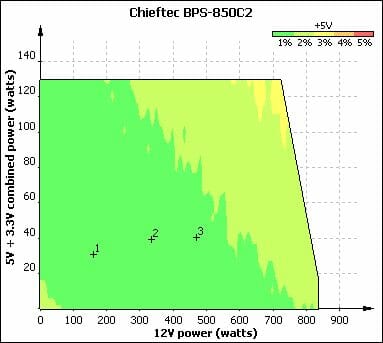
The +5 voltage is just as good. Its 3% area is larger than with the +12V voltage, but lies in the zone of very high loads on the +3.3V and +5V rails which are unlikely to occur in a real-life computer.
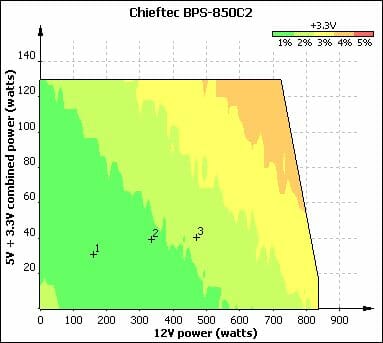
The +3.3V voltage is the least stable of all. It can be 3% off the required level in the typical load range and up to 4% off at other loads.
Output Voltage Ripple
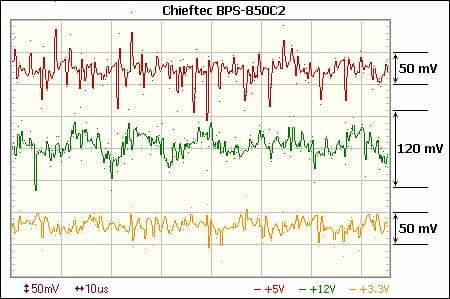
The high-frequency ripple is rather strong, barely meeting the industry requirements on the +3.3V and +12V rails. The rather frequent voltage spikes on the +5V rail are obviously beyond the permissible range.
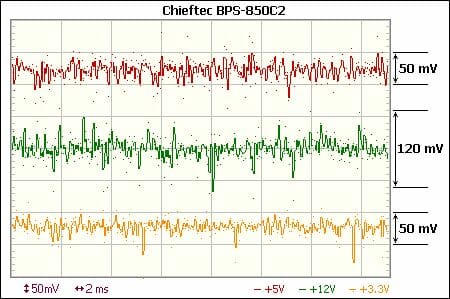
The low-frequency ripple is somewhat weaker, but the overall picture is the same.
Temperature and Noise
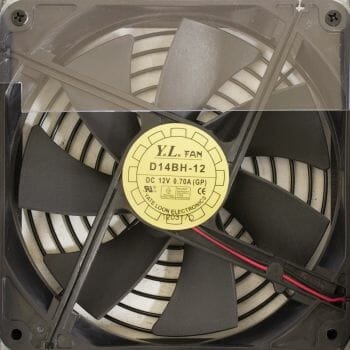
The Chieftec BPS-850C2 is cooled by a 7-blade 140mm fan from Young Lin Tech (it is the D14BH-12 model with a rated speed of 2800 RPM). Its impeller is partially covered with a piece of plastic to optimize air flows inside the PSU case.
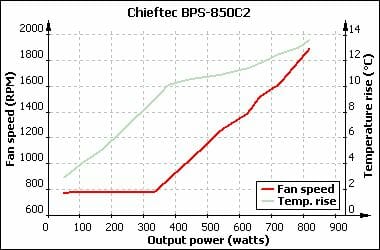
The fan starts out at a low speed of 800 RPM. It maintains the same speed until a load of 350 watts and then accelerates linearly, reaching 1900 RPM at 850 watts. The PSU’s noise becomes uncomfortable at 1000 RPM and 450 watts.
Overall, the BPS-850C2 is rather quiet at medium loads, but most of its opponents are going to be quieter at high loads.
Efficiency and Power Factor
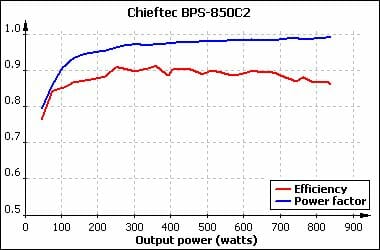
The BPS-850C2 was 20%, 50% and 100% efficient at the reference loads of 87.4%, 90.4% and 85.9% and thus meets not only 80 PLUS Bronze but even the 80 PLUS Silver requirements. Its peak efficiency of 91% could be observed at a load of 250 watts.
The power factor is over 99% at high loads, which is a perfect performance for a PSU with active power factor correction.
Standby Source
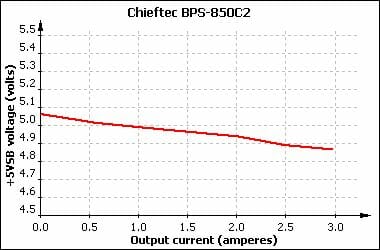
We can see no problem about the standby source.
Summary
The Chieftec BPS-850C2 is a high-efficiency PSU with modular design, stable voltages and reasonable pricing. However, it is noisy at high loads and its output voltage ripple is rather too strong.
Corsair GS800
The new series of gaming PSUs from Corsair consists of models with wattage ratings of 600, 700 and 800 watts. We’re about to take a look at the highest-wattage model.
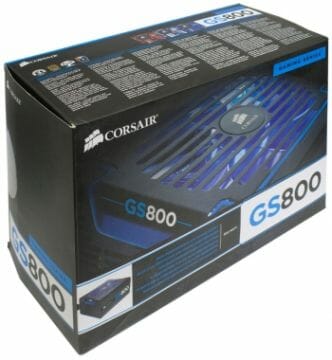
The GS800 is shipped in a medium-sized cardboard box. The packaging is individual for each PSU model in the series but follows the same design style. The difference boils down to the product’s model name and specifications on the back of the box.
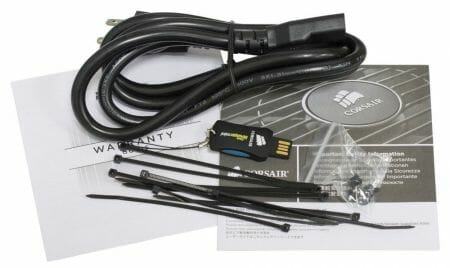
The accessories would be perfectly standard (documentation, a mains cord, screws, and single-use cable straps). We also recieved an 8 GB USB 2.0 flash drive (shown on the photo). It is not part of the standard accessories bundle, but is provided exclusively to reviewers and contains some additional benchmarking and diagnostics data.
Exterior Design
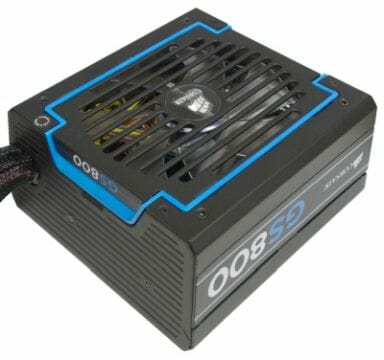
The GS800 has a very original appearance with the bevels on its sides, the decorative blue insert and the unusual shape of the vent holes. The top panel and the fan are fastened with hex-head screws. You won’t be able to open the PSU up with an ordinary screwdriver.
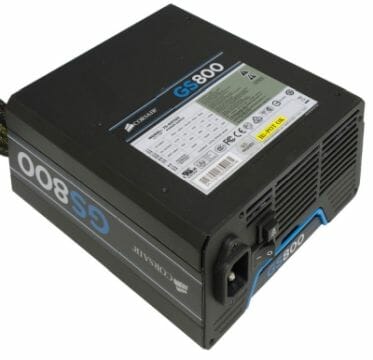
Besides the conventional elements (On/Off switch and mains connector), there is a fan highlight regulator on the back panel. You can choose from four modes: blue, white, red, no highlighting. The PSU remembers the last selected mode and uses it the next time you turn it on.
Circuit Design
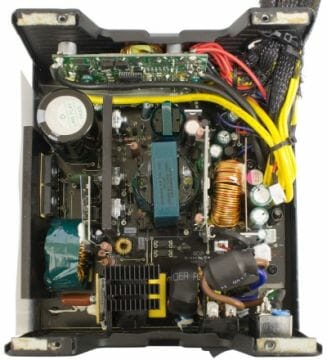
One glance is enough to see that the GS800 is based on the same Channel Well platform as the above-discussed Chieftec.
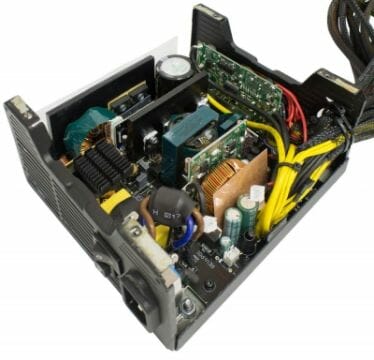
There are but minor differences concerning the ratings of some components, the different shape of the small heatsink, and the different position of the insulating screens.
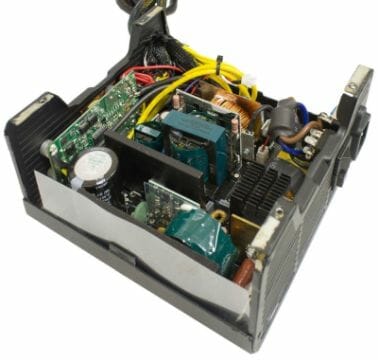
Well, the GS800 has one very obvious difference from the Chieftec, though. It lacks modular cables, so its card with DC-DC converters is designed in a different way.
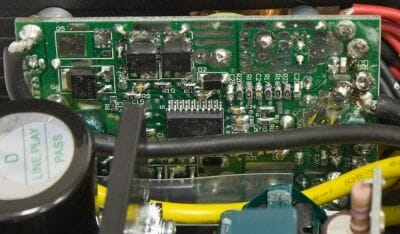
And it is this component that looks untidiest in the whole PSU.
Like the Chieftec, the Corsair GS800 employs electrolytic SAMXON capacitors at the output.
Cables and Connectors
The Corsair GS800 is equipped with the following cables and connectors:
- One mainboard cable with a 20+4-pin connector (60 cm)
- One CPU cable with a 4+4-pin connector (66 cm)
- Four power cables for graphics cards with one 6+2-pin connector on each (60 cm)
- Two cables with three PATA power connectors and a floppy-drive plug on each (44+10+10+10 cm)
- Two cables with four SATA power connectors on each (39+10+10+10 cm)
There are enough cables and connectors for any PC configuration and the CPU power cable is as long as 66 cm, which should be enough to hide it behind the mainboard in any system case.
On the other hand, the non-modular design of the GS800 implies that at least two cables for graphics cards and one PATA power cable are going to just clutter the computer’s interior in most situations.
Specifications
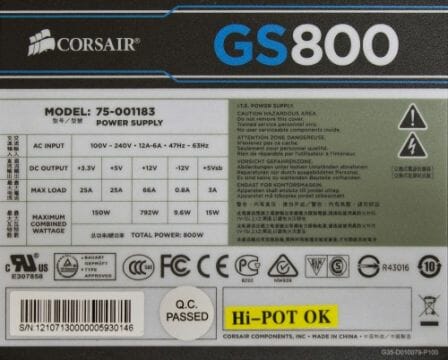
The specifications do not coincide with any model from CWT and mostly lie in between those of the CWT PUQ (B) models with wattage ratings of 750 and 850 watts.
The Corsair GS800 permits a higher combined load on the +5V and +3.3V rails than the Channel Well products from the mentioned series: 150 instead of 130 watts. But the load on each individual rail is limited to 25 amperes with any PSU based on this platform, including the GS800.
The GS800 complies with the 80 PLUS Bronze standard.
UPS Compatibility
Working together with our SmartUPS SC 620, this PSU was stable at loads up to 375 watts when powered by the mains but couldn’t switch to the UPS’s batteries even at 280 watts.
Cross-Load Voltage Stability
Every voltage always remains within 3% of the required level in this PSU:
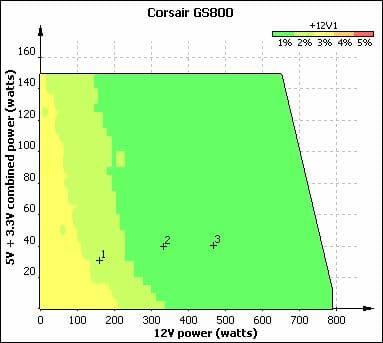
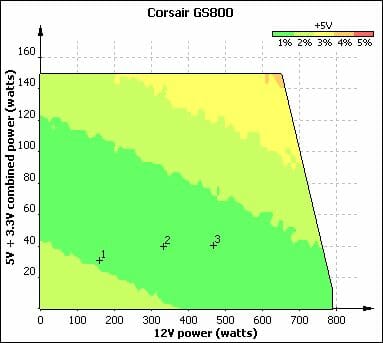
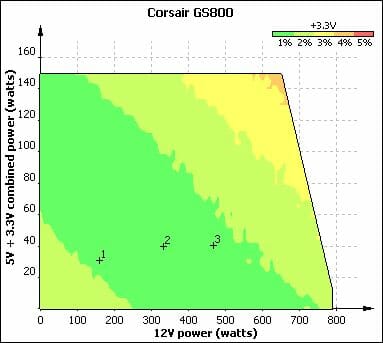
Compared to the Chieftec BPS-850C2, which is based on the same platform, the Corsair GS800 performs more consistently in this test. Its voltages deflect by the same amount on each power rail whereas the +12 and +5 voltages of the BPS-850C2 were more stable than its +3.3V voltage.
Output Voltage Ripple
The Corsair GS800 is preferable to the Chieftec BPS-850C2 in terms of voltage spikes:
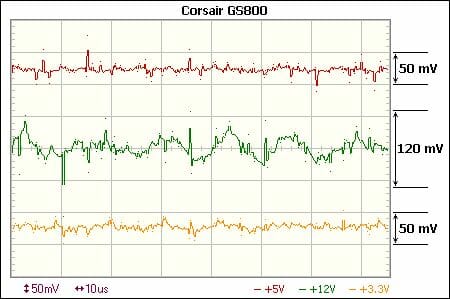
The high-frequency ripple isn’t as good as with the best PSUs we’ve seen, yet easily meets the industry requirements.
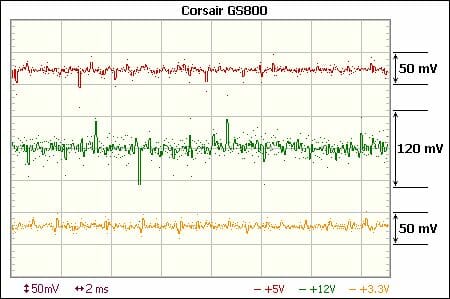
The low-frequency ripple is even weaker, the perfect picture being only spoiled somewhat by the occasional spikes on the +12V rail.
Temperature and Noise
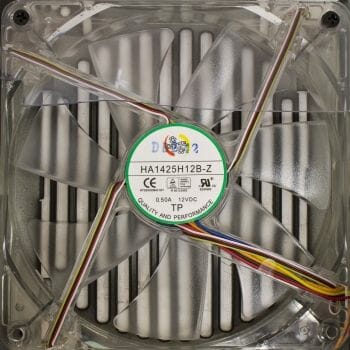
The Corsair GS800 is cooled by a 7-blade 140mm Ong Hua HA1425H12B-Z fan. It is partially covered with a piece of plastic to optimize air flows inside the PSU case.
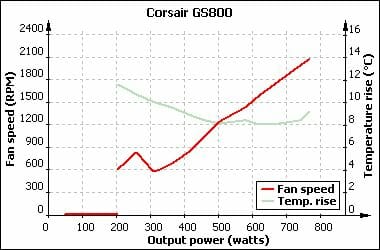
The fan doesn’t work at all at low loads, making the PSU absolutely silent. It is only at loads over 200 watts that the fan turns on for a while at a low speed. It begins to work without intermissions at loads higher than 300 watts. Unfortunately, the fan isn’t quiet even at the minimum speed, producing some rattle.
As soon as the fan gets to work constantly, its speed accelerates in a linear manner. The subjectively comfortable limit of 1000 RPM is reached at a load of 450 watts. At full load the fan works at 2100 RPM.
Thus, it is hard to evaluate the Corsair GS800 in terms of noisiness. On one hand, it is silent at very low loads but, on the other hand, it is too loud for its class at high loads.
Efficiency and Power Factor
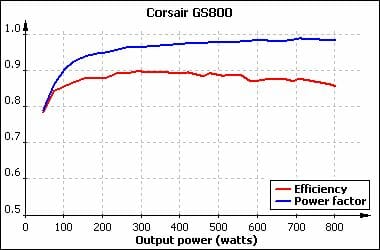
The Corsair GS800 was 87.8%, 89.3% and 85.3% efficient at the reference loads of 20%, 50% and 100%. Like the similarly-designed Chieftec, it meets not only 80 PLUS Bronze but even the 80 PLUS Silver requirements. The peak efficiency was 89.9% at 292 watts.
The power factor is close to 99% at high loads, which is what you can expect from a PSU with active power factor correction.
Standby Source
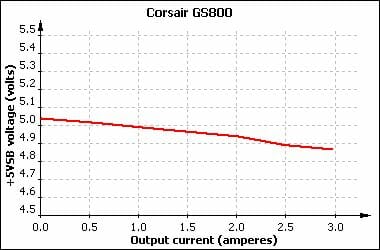
The standby source works flawlessly.
Summary
The Corsair GS800 is very similar to the Chieftec BPS-850C2 except for minor differences. It is somewhat better in terms of output voltage ripple and features an original exterior with a highlighted fan. The Chieftec, on its part, offers more output power, has modular cables and is somewhat more efficient.
Cooler Master Silent Pro M2 850W
This PSU hails from the same series as the earlier tested Silent Pro M2 1000W.
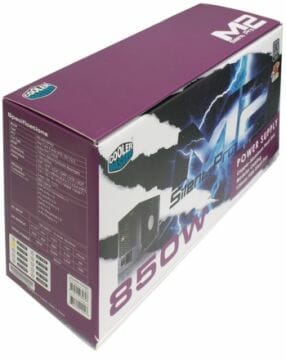
The packaging is the same except for the model name and specifications. The accessories include a user manual, a mains cord, and mounting screws.
Exterior Design
The Silent Pro M2 850W looks exactly like its higher-wattage cousin we tested earlier. It doesn’t have the latter’s manufacturing defects, though.
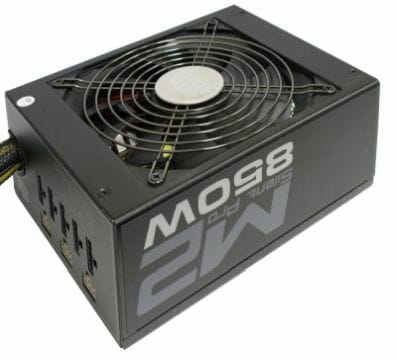
There are some original traits in its appearance like the curved-in fan grid. The gray-black color scheme makes it look quite imposing.
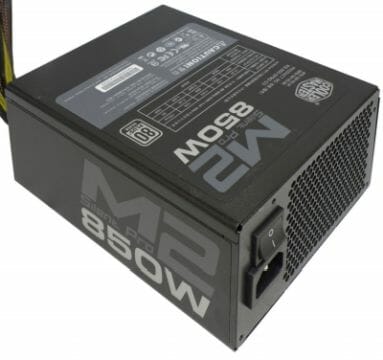
Besides a mains connector and a large On/Off switch, we can see a honeycomb vent grid on the back panel. The grid doesn’t occupy the entire panel, though.
Circuit Design
The Silent Pro M2 850W is identical to its 1000W cousin in terms of the interior design.
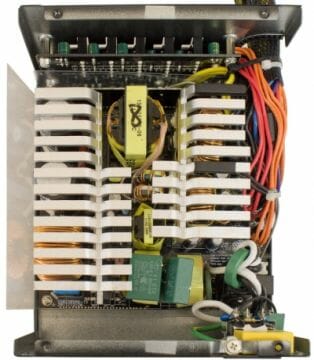
Upon closer inspection we find that we were wrong suggesting that this series lacked dedicated voltage regulation.
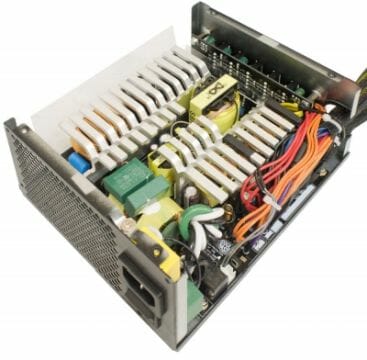
Notwithstanding the lack of DC-DC converters and the presence of only a couple of chokes, the PSU indeed regulates its voltages independently. The +5V and +3.3V voltages are just regulated with one choke.
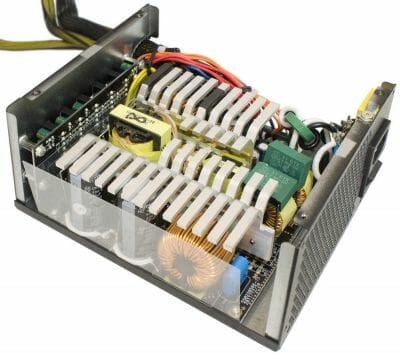
A conspicuous difference from the 1000W model is the lack of a third small heatsink between the large heatsink near the A-PFC choke and the input filter chokes. A power component is missing there, so there’s no need to cool it anymore.
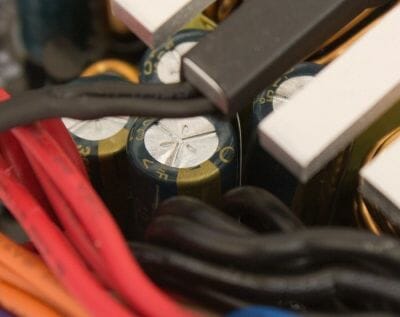
Like the 1000W model, the Silent Pro M2 850W uses different brands of capacitors on its output. There are Teapo components next to the small choke that regulates +3.3V and +5V.
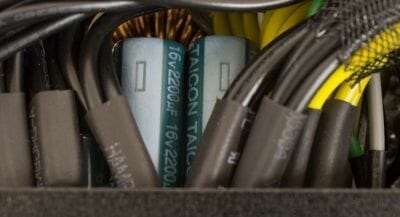
Taicon capacitors can be found near the large +12V choke.
Cables and Connectors
The Silent Pro M2 850W is equipped with the following cables and connectors:
- One mainboard cable with a 20+4-pin connector (55 cm)
- Two CPU cables with an 8-pin connector (60 cm)
- Three connectors for graphics card cables
- Five connectors for peripheral power cables
Included with the PSU are:
- Three power cables for graphics cards with one 8-pin and one 6+2-pin connector on each (65+10 cm)
- One cable with three PATA power connectors (50+11+10 cm)
- One cable with two PATA power connectors and a floppy-drive plug (76+10+11 cm)
- Two cables with four SATA power connectors on each (50+10+10+10 cm)
- One cable with four SATA power connectors (76+10+10+10 cm)
The selection of cable and connectors is identical to the 1000W model’s (except that our sample of the 1000W model had a defective cable with three instead of four SATA connectors). So, our criticism remains the same. We don’t like that it has three 8-pin graphics card connectors (you won’t be able to power even a pair of graphics cards with two 6-pin connectors on each unless you employ adapters) and that it lacks a 4-pin CPU power connector.
Specifications
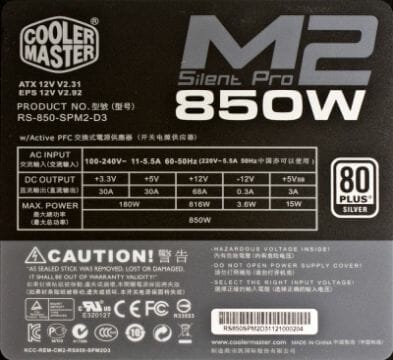
The specs are identical to those of the 1000W model except for the load capacity of the +12V rail. We can note that the Silent Pro M2 850W has a redundant load capacity of the +5V and +3.3V rails combined: a modern computer can hardly need even one third of the permissible maximum of 180 watts. However, considering that the +12V rail can yield almost all of the PSU’s total output power, leaving a mere 34 watts to the other rails, this is not a downside but just a not very required feature.
The Silent Pro M2 850W complies with the 80 PLUS Silver standard.
UPS Compatibility
Working together with our APC SmartUPS SC 620, the PSU was stable at loads up to 402 watts when powered by the mains but could only switch to the UPS’s batteries at 290 watts. This is a little better than the performance of the 1000W model from the same series in this test.
Cross-Load Voltage Stability
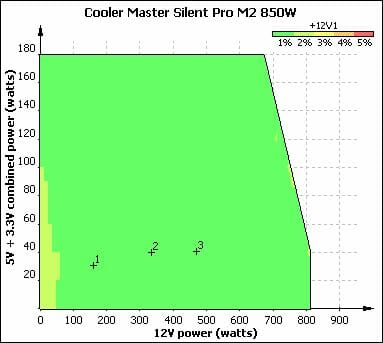
The most important +12V rail sports immaculate stability. It remains within 1% of the required level at most loads and is never even 2% off.
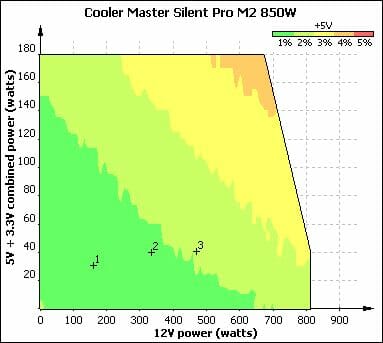
The +5V voltage remains within 3% of the required level in the typical load range. Except for high loads on the +12V rail, the +5V voltage is no more than 2% off.
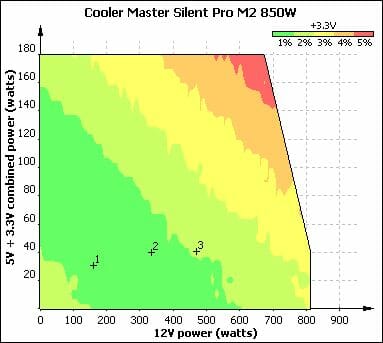
Although the +3.3V voltage may deflect by up to 5%, which is the permissible maximum, it remains within 3% in the typical load range.
Overall, the Silent Pro M2 850W performs like its 1000W cousin except that its +12V voltage is somewhat more stable.
Output Voltage Ripple
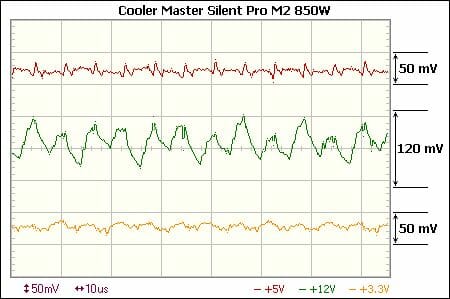
The high-frequency voltage ripple is within the norm on each power rail. It is very weak on the +5V and +3.3V rails.
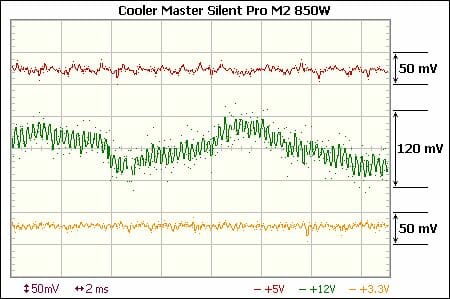
The same goes for the low-frequency ripple. It is close to the permissible maximum on the +12V rail but weak on the other rails.
Temperature and Noise
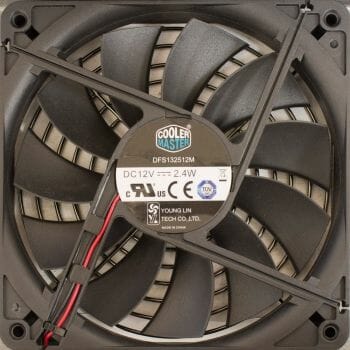
Like its 1000W cousin, the Silent Pro M2 850W is cooled by an 11-blade 135mm Young Lin Tech DFS132512M fan which has a rated speed of 1500 RPM.
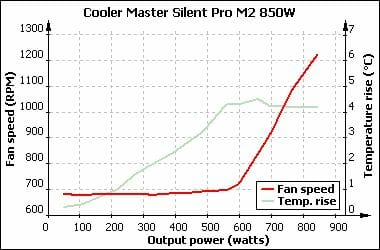
The start speed of the fan is below 700 RPM and doesn’t change until a load of 600 watts. Then the fan accelerates quickly but cannot reach even 1250 RPM over the remaining 200 watts. As a result, the Silent Pro M2 850W is a very quiet model in its class.
Efficiency and Power Factor
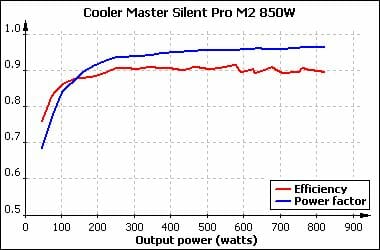
The Silent Pro M2 850W is 88.1%, 90.2% and 89% efficient at the reference loads of 20%, 50% and 100%. It thus meets even the 80 PLUS Gold requirements (and by a large margin, except at 50% load). The peak efficiency of 91.5% was observed at a load of 579 watts.
The power factor is in between 96 and 97% at high loads, which is somewhat lower than we usually get from PSUs with active power factor correction.
Standby Source
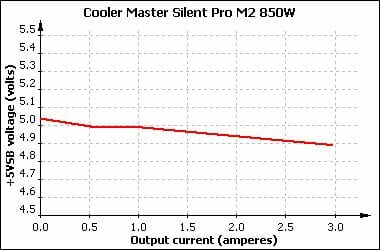
The standby source can easily cope with the specified loads.
Summary
The Silent Pro M2 850W features an original exterior design and excellent electrical parameters. It is very quiet, too. But its cable system isn’t optimal and the Taicon capacitors do not enjoy a good reputation among users.
Seasonic SS-860XP
As is the case with the above-discussed Cooler Master, we’ve already tested the 1000W cousin of this Seasonic SS-860XP.
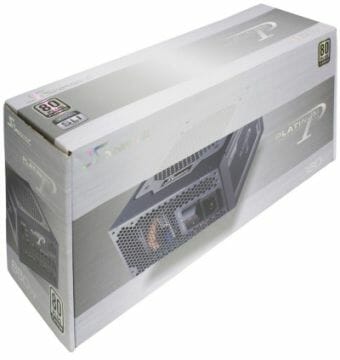
The packaging is almost the same except for the model name and specifications.
The accessories now include more cable straps and a simple screwdriver. There’s still a black velvet pouch for the PSU and a silver-black bag for modular cables.
Exterior Design
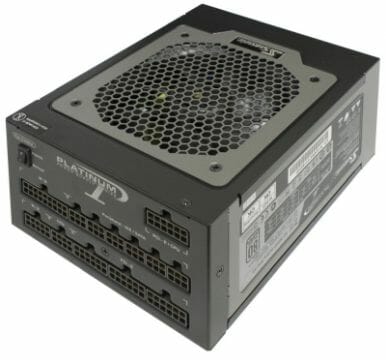
Like its 1000W cousin, the Seasonic SS-860XP is painted gray and black. Besides the connectors for modular cables, there is a cooling system regulator on the front panel. It can be set at normal (the fan starts up immediately at low speed) and hybrid (the fan is turned off at low loads).
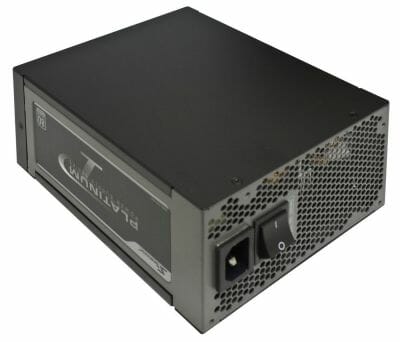
The PSU is overall identical visually to the SS-1000XP model.
Circuit Design
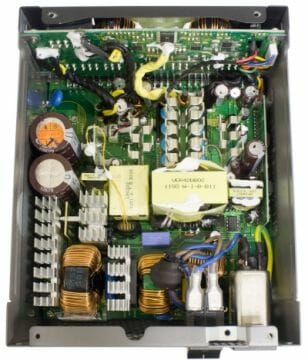
The interior design isn’t much different from the senior model’s. There are two rather than three capacitors at the input and fewer solid-state capacitors at the output. Some components have different ratings.
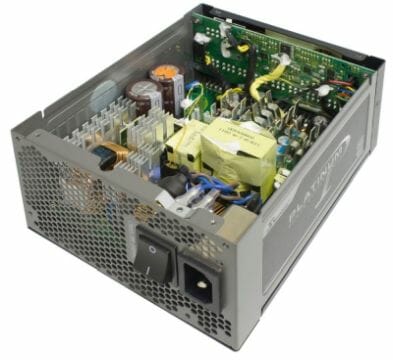
As is typical of top-end Seasonic products, DC-DC converters are placed on the card with modular connectors.
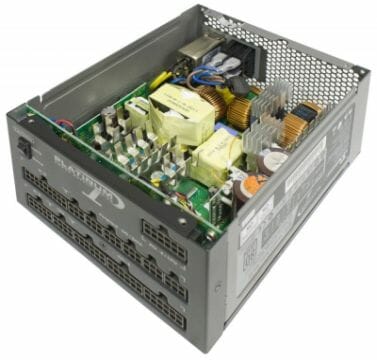
Not all manufacturers can ensure low voltage ripple with such components, but Seasonic usually has no problems with that.
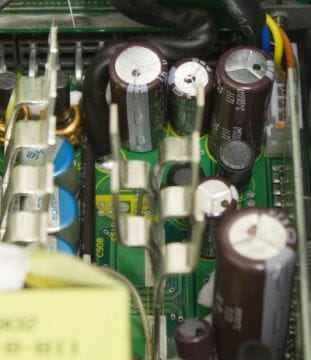
The PSU employs electrolytic capacitors from United Chemi-Con at the output. These components enjoy an excellent reputation.
Cables and Connectors
The Seasonic SS-860XP is an all-modular PSU. It is shipped with the following cables:
- One mainboard cable with a 20+4-pin connector (60 cm)
- One CPU cable with an 8-pin connector (65 cm)
- One CPU cable with a 4+4-pin connector (65 cm)
- 2 graphics card power cabled (with two independent cables in each) with 6+2-pin connectors (60 cm)
- Two cables with three PATA power connectors on each (55+15+15 cm)
- One cable with two PATA power connectors (35+15 cm)
- Three cables with three SATA power connectors on each (55+15+15 cm)
- One cable with two SATA power connectors (35+15 cm)
- Y-shaped adapter from a PATA power connector to two floppy-drive plugs (14 cm)
The selection of cables and connectors is the same as the 1000W model offers with only one exception: there are only two instead of three power cables for graphics cards in the box. The PSU offers enough cables and connectors and the cables are sufficiently long.
Specifications
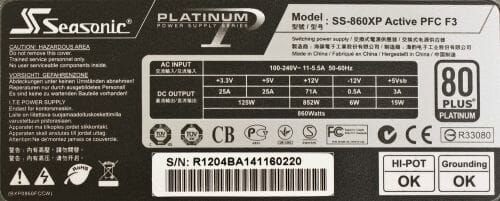
Quite expectedly, the specs coincide with those of the 1000W model except for the load capacity of the +12V rail. Following today’s trends, the load capacity of the +3.3V and +5V rails is low but the PSU can yield almost all of its output power via the +12V rail.
This PSU complies with the 80 PLUS Platinum standard which is the highest certification among the PSUs in this review.
UPS Compatibility
Working with our APC SmartUPS SC 620, this PSU was stable at loads up to 430 watts when powered by the mains and could switch to the UPS’s batteries at 340 watts.
Cross-Load Voltage Stability
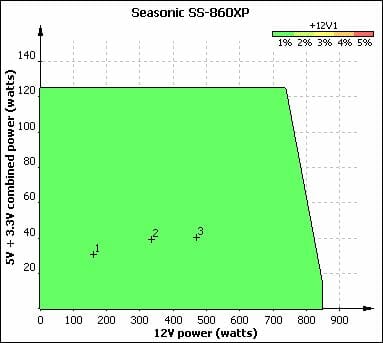
The main +12V voltage is perfect. It is never even 1% off the required level at any load.
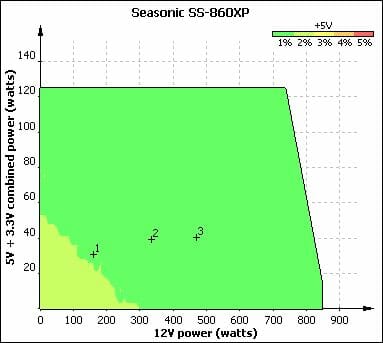
The +5V voltage is immaculate as well. It is only at low loads that it is more than 1% off.
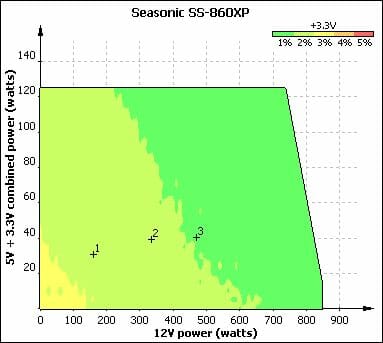
The +3.3V voltage is not that stable. It deflects by more than 2% at minimum loads (although Seasonic promises its Platinum-certified PSUs to keep voltages within 2% on every power rail).
Anyway, the PSU is exemplary in terms of output voltage stability.
Output Voltage Ripple
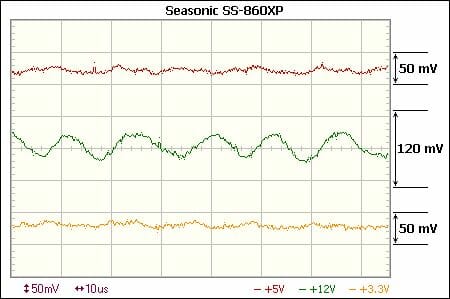
Although the voltage ripple isn’t strong, we’ve seen Seasonic PSUs perform better in this test. The high-frequency ripple is weak on the +3.3V and +5V rails but conspicuous on the +12V rail. On the other hand, it’s only half the permissible maximum even on the +12V rail.
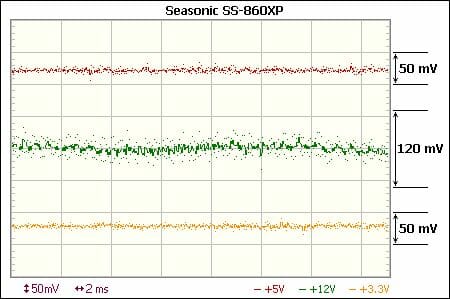
At the double frequency of the mains the voltage ripple on the +12V rail isn’t that strong, though.
Temperature and Noise
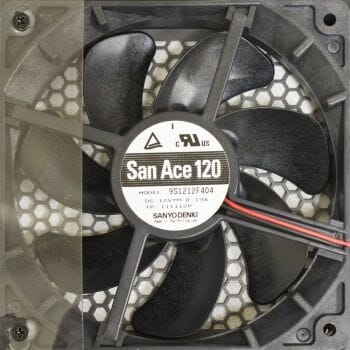
As other top-end Seasonic PSUs, the SS-860XP is cooled by a 120mm fan Sanyo Denki San Ace 120 (model name: 9S1212F404, rated speed: 2200 RPM). You can refer to our earlier reviews for details about this fan’s advantages and special features.
We tested the SS-860XP in both operating modes of its fan.
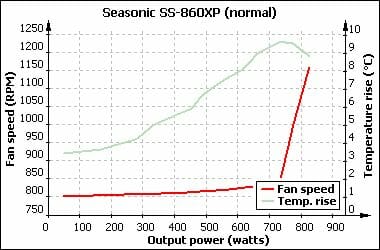
In the Normal mode the fan has a start speed of about 800 RPM and maintains it until a load of 700 watts. Then the fan accelerates suddenly but doesn’t reach even 1200 RPM at full load, making the PSU virtually silent all the time.
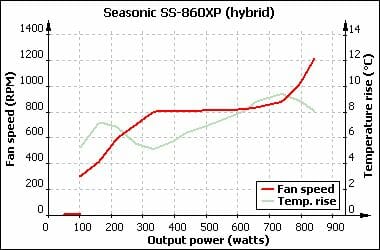
In the Hybrid mode the fan is idle at low loads or turns on but for a little while. This mode doesn’t differ from the Normal one at loads above 300 watts when the fan rotates constantly.
The Seasonic SS-860XP is one of the quietest models in its class. For example, the above-discussed Cooler Master turns out to be noisier at the same speed of the fan because its fan is larger and not as high quality as the Sanyo Denki.
Efficiency and Power Factor
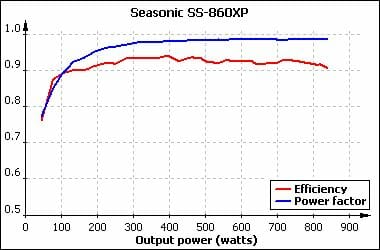
The Seasonic SS-860XP is 90.4%, 92.9%, and 90.5% efficient at the reference loads of 20%, 50% and 100%, which agrees with the 80 PLUS Platinum requirements. The peak efficiency was 94.2% at 395 watts.
The power factor is 98 to 99% at most loads, which is normal for a PSU with active power factor correction.
Standby Source
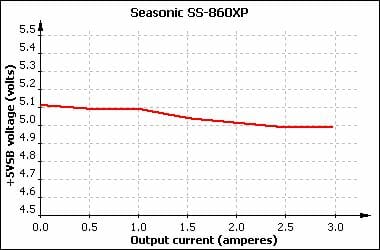
The standby source copes with its job without any problems.
Summary
The Seasonic SS-860XP is a masterpiece with its superb electrical parameters, very quiet operation, handy modular design and stylish appearance. It is priced accordingly, though.
Conclusion
The Chieftec BPS-850C2 and the Corsair GS800 are similar from a technical standpoint and do not differ much in price. The Chieftec can offer semi-modular design, somewhat higher output power and better efficiency whereas the Corsair has an original exterior, highlighting and lower voltage ripple. Both are quiet at medium loads (especially the Corsair), but become noisy at high loads (again, especially the Corsair).
The Cooler Master Silent Pro M2 850W is much quieter than the mentioned pair at high loads while its electrical parameters are overall better. However, it costs considerably more while its cable system isn’t optimal (we mean the connectors for graphics cards in the first place).
The Seasonic SS-860XP is a real technical masterpiece, but costs almost twice as much as the Cooler Master Silent Pro M2 850W. We wouldn’t say that it is twice as good in terms of consumer properties. On the other hand, we have no doubt this PSU will find its customer even at its current price.